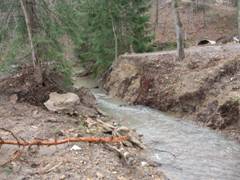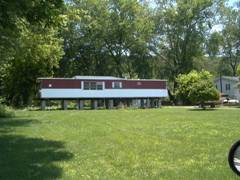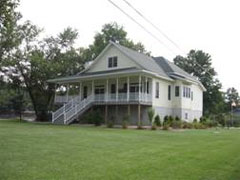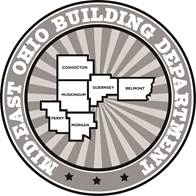Building Department
The Mid-East Ohio Building Department is a state certified commercial building department. The department issues plan approvals (permits) and inspects all building activity regulated by the Ohio Building Code in Muskingum County as well as a region which includes five additional counties: Belmont, Coshocton, Guernsey, Morgan, and Perry County. There are five municipalities in Belmont County that are excluded. Please see the Jurisdiction List for those areas.
(View Jurisdiction List)
The Muskingum County Floodplain Department functions out of the same office. The Floodplain Department issues permits and inspects all floodplain development activity in the FEMA Special Flood Hazard Areas of Muskingum County.
This department does NOT have authority over one, two, or three family dwellings/homes.
***THIS DEPARTMENT HAS NO AUTHORITY OVER ZONING***
Online Plan Submission & Secure Online Payments
Submit your Building or Sign Application by choosing the appropriate application below. There is a link at the end of the application for you to securely submit your payment and plans/drawings.
If this is a revision or update to an existing project, use our “Plan Update/Revision” link below. If you do not know your Plan Approval #, use the name or address of the project.
If additional fees are required, use the “Access Online Payments” link below.
View/Download Application and Fee Schedule
Secure Online Payments
Conveniently and securely pay your fees online through our payment portal.
Please note that there is a 3% fee charged by the credit card carrier.
Building Standards Used
- 2024 Ohio Building Code (Based in 2021 ICC Code)
- 2024 Ohio Plumbing Code (Based in 2021 ICC Code)
- 2024 Ohio Mechanical Code (Based in 2021 ICC Code)
- 2017 Ohio Fire Code
- 2021 International Existing Building Code
- 2022 NEC (NFPA 70)
- 2022 NFPA 13, NFPA 13R, NFPA 13D – Automatic Sprinkler System Handbook
- 2023 NFPA 72 – National Fire Alarm and Signaling Handbook
- 2021 International Fuel Gas Code
- 2021 International Energy Conservation Code
- ICC A117.1-2009 (Alterations and Changes to Existing)
- ICC A117.1-17 (New Construction)
Department Forms & Downloads
Floodplain
- About
- Flood Insurance
- Permit Information
- Resources & Links
Historically, people have been attracted to bodies of water as places for living, industry, business, and recreation. These areas became centers of transportation water supply, and water power. Additionally, these regions were commonly areas with fertile soils that attracted agriculture. As these areas were developed, natural forces of flooding became a cause of damage and destruction.
Flooding is a natural and beneficial function of stream or lake systems. Floods occur when rivers, streams or lakes overflow their banks and spill onto the adjacent land area, which is called a floodplain. Natural controls on flooding and erosion help to maintain water quality by filtering nutrients and impurities from runoff, processing organic wastes, and moderating temperature fluctuations. Floodplains enhance biological productivity by supporting a high rate of plant growth. People benefit from floodplains through the food they provide, the recreational opportunities they afford, and the scientific knowledge gained in studying them.
Loss of life and property can result when people build structures and carry out other development in flood hazard areas. Many factors can cause flooding in Ohio including: heavy and/or prolonged periods of rainfall, snowmelt, soil saturation, ground freeze, severe wind events, and insufficient drainage systems. They can occur at any time of the year, in any part of the country, and at any time of the day or night. Most lives are lost when people are swept away by flood currents, whereas most property damage results from inundation by sediment-laden water. Flood currents also possess tremendous destructive power, as lateral forces can demolish buildings and erosion can undermine bridge foundations and footings leading to the collapse of structures.
Flooding is the most frequently occurring natural disaster in Ohio and the United States. During the 20th century, floods were the number-one natural disaster in the United States in terms of the number of lives lost and property damage. In Ohio, there are many types of flooding that occur, including riverine, flash flooding, coastal flooding, and shallow flooding. Floods damage private and public property and infrastructure in Ohio every year.
A Base Flood is a flood that has a one percent chance of being equaled or exceeded in any given year. The base flood is also referred to as the 1% chance annual flood or one‑hundred (100) year flood. During a 30 year mortgage, there is a 26% chance of being hit with a 100 year flood (base flood) in the floodplain. There is a 1-2% chance that the house will catch fire during the same 30 year mortgage.



The National Flood Insurance Program (NFIP) is the primary source for flood insurance in the United States.Flood insurance can be purchased from a licensed private insurance company or independent property and casualty insurance agent.
The NFIP has evolved over time with the following federal legislation and Presidential Executive Orders:
- The Flood Control Act of 1917 gave the Corps of Engineer authority to (1) build and maintain dams (2) engage in channel modifications (3) construct levees and floodwalls.
- The Tennessee Valley Authority (TVA) Act of 1933 established the TVA and its scope of managing resource development, dam construction, and flood control projects.
- House Document 465 of 1966 proposed major policy recommendations for flood loss reduction.
- The Southeast Hurricane Disaster Relief Act of 1965 directs the Department of Housing and Urban Development to examine financial assistance options for flood victims. Housing and Urban Development concluded that a National Flood Insurance Program was feasible.
- The National Flood Insurance Act of 1968 was passed by congress to correct the shortcoming of traditional flood protection and flood relief programs. The National Flood Insurance Program (NFIP) makes low-cost subsidized flood insurance available to property owners in communities that adopt minimum flood hazard regulations for development in floodplain areas in a manner consistent with both nature’s need to convey floodwaters and a community’s land use needs. In Ohio, over 700 communities participate in the NFIP. The NFIP allows communities to adopt stricter floodplain ordinances if they wish.
- The Coastal Zone Management Act of 1972 authorizes coastal floodplain management plans.
- The Water Pollution Control Act of 1972 authorizes permit procedures for dredging and placing fill materials in bodies of water. It also requires permits for municipal and industrial discharges.
- The Flood Disaster Protection Act of 1973 includes incentives to participate in the NFIP and requires that localities enforce their local floodplain ordinance or they will be removed from the NFIP.
- The Water Resources Development Act of 1974 encourages nonstructural approaches to floodplain management.
- Executive Order 11988 mandates that Federal agencies avoid floodplains when possible and comply with NFIP minimum standards.
- Executive Order 11990 requires that Federal agencies avoid wetlands.
- The National Flood Insurance Reform Act of 1994 prohibits federal disaster assistance in cases were flood insurance has not been maintained. Also provides 75/25 cost share grants to states and communities. It provides up to $1.5 million for state/community mitigation planning. It also establishes flood insurance rates based on (in part) the risk the structure has of being damaged by flooding. "Substantial Damage" is defined as when the cost of compliance exceeds 50% of the market value of the structure in question. It also establishes a 30-day waiting period before NFIP policies become effective.
Floodplain development activity includes but is not limited to: Residential, non-residential, manufactured. All structural and non-structural development activity in a designated FEMA Flood Zone requires a permit.
A Floodplain Permit Application must be completed and submitted to the Muskingum County Floodplain Department prior to any development activity.
The permit fee for floodplain development activity is $100 for structural activity and $50 for non-structural activity. The fee is payable to: Muskingum County Floodplain Department, located at 22 N. 5th Street, Zanesville, Ohio 43701.
Development activity should not begin until all permits are issued.
Structural development activity includes any walled or roofed building, manufactured home or gas or storage tank that is principally above ground in a designated FEMA Flood Zone. Structural development activity includes but is not limited to: New homes, accessory buildings, material storage buildings, and gas or storage tanks, alterations and additions to homes, accessory buildings, and material storage buildings.
Non-structural development activity is all other activity in a designated FEMA Flood Zone which includes but is not limited to: Excavation, driveways, agriculture levies, bridge replacement, maintenance, lake/ponds, landscaping, riprap (bank stabilization), land clearing.
Other permits for floodplain activity that may be required are: Health Department, Township Zoning, County Subdivision, Ohio EPA 401, Corps of Engineers Section 404, Corps of Engineers Section 10.
Flood Insurance through the National Flood Insurance Program (NFIP) will be required if a mortgage is carried on the property.
NFIP insurance premiums are based on risk determined by the exposure to potential flood damage.
Risk for flood damage is reduced if the structure complies with the local floodplain regulations.
Specific Floodplain Development information can be obtained from the Floodplain Office at 22 N. 5th Street, Zanesville, Ohio 43701.
Phone: 740-455-7905
Fax: 740-455-7907
E-mail: Ray Mennega rnmennega@muskingumcounty.org
Chief Building Official

| Contact Our Office | |
|---|---|
| Location | 22 North 5th Street, Zanesville, Ohio |
| Hours | Monday – Friday, 8:00 a.m. – 4:30 p.m.
Closed all legal holidays |
| Phone | (740) 455-7905 |
| Fax | (740) 455-7907 |
Mid-East Ohio Building Department
